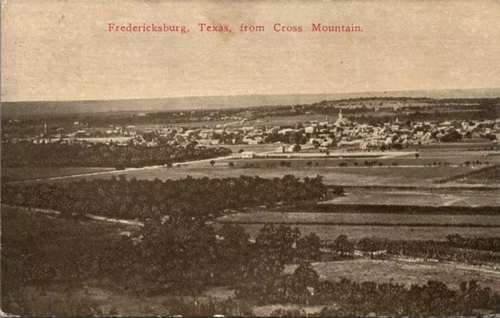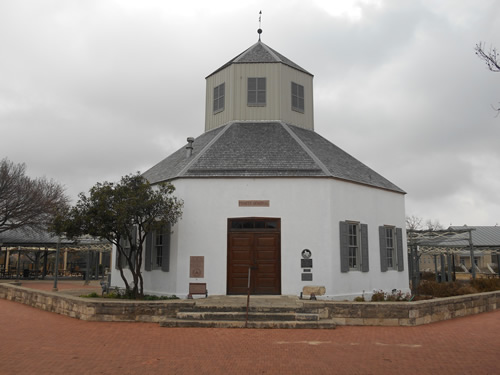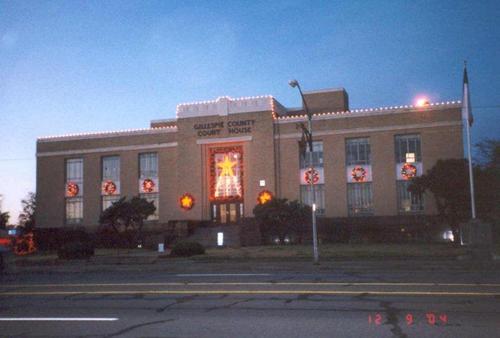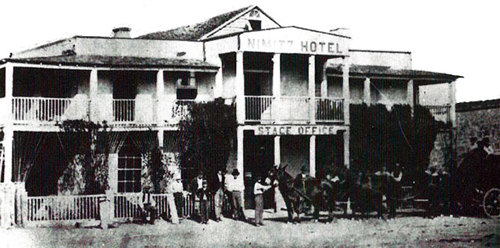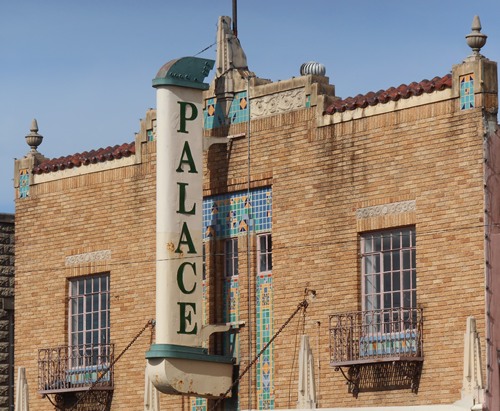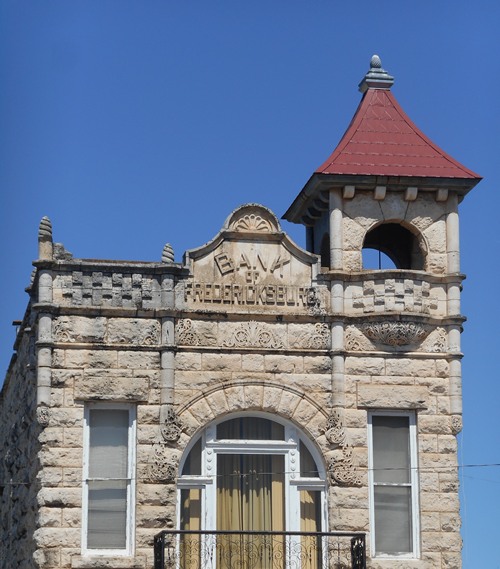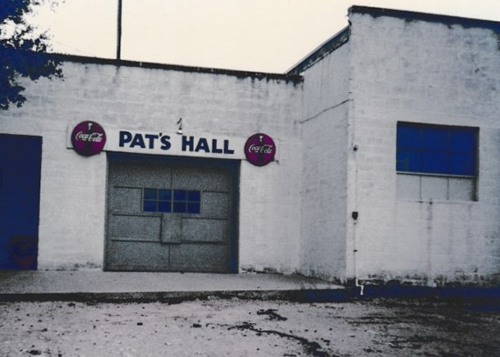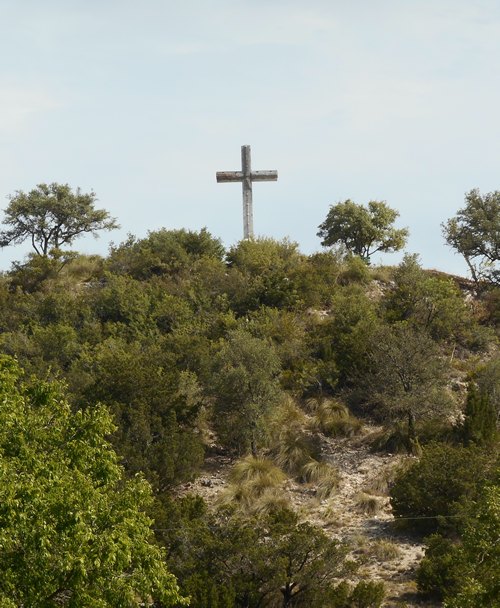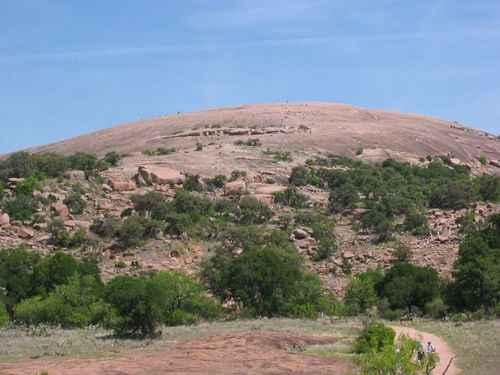Fredericksburg, Texas, Gillespie County seat. (original) (raw)
History in a Pecan Shell
Named in honor of Prince Frederick of Prussia, Fredericksburg had been the inland destination of the German immigrants who came to Texas through the port of Indianola. John O. Meusebach left New Braunfels in the summer of 1845 to survey the area with the first 120 settlers arriving the next spring.
The trip which now takes an hour took the settlers 16 days.
After the town was platted, each family settler received a town lot and ten acres outside of town. plan was a replica of the villages back in Germany. The earliest houses were log cabins that were soon replaced with Fachwerk buildings.
Despite an epidemic that killed a tenth of the settlers, Fredericksburg soon had a respectible population of nearly 1,000. A road was built connecting Fredericksburg and Austin; and John Meusebach brokered a successful treaty with the Comanches.
Frederickburgs most important building was the Vereins-Kirche. Before it was razed in 1897, the structure had served as fort, church, school, and town hall. Restored in 1936 for the Centennial, the replica building now serves as offices for the Gillespie County Historical Society.
Religious services had all been held in the Vereins-Kirche, until 1848 when Catholics built their own church.
Photo Courtesy Shannon Yarbrough, May 2005
The United States Army established Fort Martin Scott, which became a boon to the local economy. Once cannibalized for its building stone, the fort is now defined by a reconstructed building - with more planned. Soon after the Texas legislature made Fredericksburg the Gillespie county seat.
The Forgotten Indian Traveler by Mike Cox
The men were Richard Irving Dodge, a young Army officer who would serve in the military for 41 years and John Conner, a noted Delaware Indian. The meeting happened at Fort Martin Scott...
Thirty years went by before Dodge got around to writing about his experiences at Fort Martin Scott in his classic book, �The Wild Indians.�
The first newspaper appeared (in German) in 1877, and it wasn't until after 1900 that were the first purely English-speaking teachers employed in Fredericksburg's public schools.
The first Gillespie County Fair (also believed to be the first in Texas) was held at Fort Martin Scott in 1881. By 1904 the population was 1,632. The San Antonio, Fredericksburg and Northern Railway, arrived in November of 1913. The railroad later became the Fredericksburg and Northern and stayed in business until WWII.
In 1928 citizens voted to incorporate. Up until then Fredericksburg had been the largest unincorporated town in the United States. It participated in a census for the first time in 1930 (giving a number of 2,416).
Fredericksburg became the counties manufacturing center and local quarries supplied both granite and limestone. The Gillespie County Historical Society was founded in 1934 to preserve local history and traditions.
Another historic building is the former Nimitz Hotel - the boyhood home of Admiral Chester Nimitz, Commander of the Pacific Fleet during WWII.
Fredericksburg, Texas
Landmarks / Attractions
The Fredericksburg Historic District was added to the National Register of Historic Places in Texas on October 14, 1970.
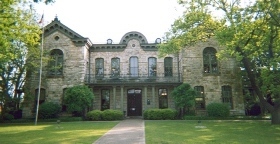 |
The 1882 Gillespie County Courthouse now used as the Gillespie County Library. Photo Courtesy Shannon Yarbrough |
|---|
The Former Gillespie County Courthouse c.1882
On the Public Square near the current courthouse.
Designed by Alfred Giles, English Architect turned Texas Sheep Rancher
"...with its formal balance, heavy decorative consoles, and Classical roof slopes, [it possesses] the dignity characteristic of Renaissance Revival buildings." - Williard B. Robinson, Texas Public Buildings of the Nineteenth Century

The 1885 Gillespie County Jail in Fredericksburg
Photo courtesy Michael Barr, January 2021
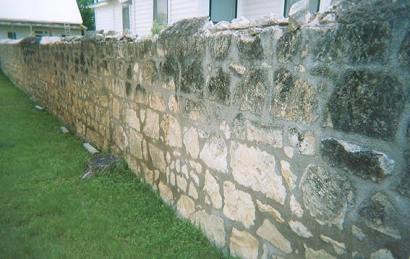
The Jail Wall
Photo Courtesy Shannon Yarbrough, May 2005
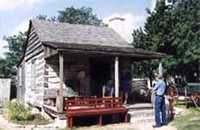 |
Authentic cabin relocated to Pioneer Museum Complex on Main Street Courtesy of Sandy Fiedler |
|---|
From
"Blending German Colonization with Modern Tourism " by Sandy Fiedler:
"Today Main Street shows off dozens of marvelous shops for collectibles, antiques, crafts, etc. There are German restaurants, beer gartens, and bakeries (with shortbread, baked meringue, kolaches). The pleasing scents of candles fill the nostrils. Unobtrusive doorways lead to mysterious courtyards. Many of the ubiquitous historical markers are noticeable only if you are on foot in this understated, rich historical district. Churches stand all over the town like watchtowers of strength."
 |
Admiral Nimitz State Historic Site - National Museum of the Pacific War P O Box 777 Fredericksburg TX 78624 830/997-4379 Courtesy of Sandy Fiedler |
|---|
"On Main Street is the Admiral Chester Nimitz Museum and Historical Center. Fredericksburg is proud to be the birthplace of Nimitz, Fleet Admiral of the Pacific Forces in World War II. This museum is part of the National Museum of the Pacific War with the new George Bush Gallery.
"There are many bed and breakfast establishments and motels-there are no bad places to stay in Fredericksburg," voiced one resident. "Everything is clean and safe."
...You can regain a sense of what it used to be if you start with a tour of the Pioneer Museum Complex on Main Street in Fredericksburg.
A Founders' Day Festival is held there every May."
� Sandy Fiedler
Photo courtesy Texas Transportation Museum in San Antonio

Photo courtesy courtesy Gillespie County Historical Society

Marienkirche (Old St. Mary's Church)
Photo Courtesy Shannon Yarbrough
Marienkirche (Old St. Mary's Church) c. 1848
Built under the direction of Benedictine priest Peter Baunach, the church was built by its members.
According to architectural historian Williard B. Robinson, "the aisles were paved by soapstone flagging, but the floor under the pews was covered with sand."
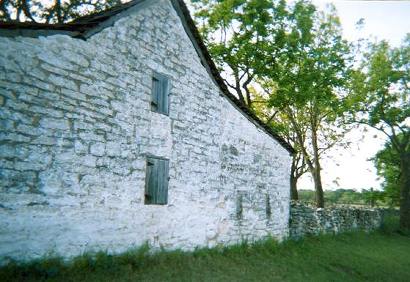
Hohenberger Homestead
Another example of German masonry.
Photo Courtesy Shannon Yarbrough, May 2005
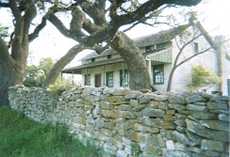 |
Stone walls remain as noteable landmarks for Fredericksburg. Photo Courtesy Shannon Yarbrough, May 2005 |
|---|
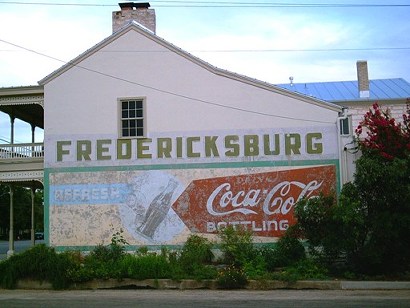
A Coca Cola sign in Fredericksburg
Photo courtesy Shannon Yarbrough
Fredericksburg's Post Office Mural "Loading Cattle" by Otis Dozier, 1939
Photo Courtesy Shannon Yarbrough, 5-2005
More Post Office Murals
Fredericksburg Chronicles:
- Magic Moments with Satchel Paige by Michael Barr
The legendary pitcher Leroy "Satchel" Paige 10-1-23 - Lady Bird's Gift to St. Barnabas Church by Michael Barr 8-5-23
- The Girl Scout Cabin by Michael Barr 7-15-23
- Cool Times at the Ice House by Michael Barr 6-15-23
- Bakeries Rise to the Occasion by Michael Barr 6-1-23
- Towns and Parking Meters: A Complicated Relationship by Michael Barr 5-1-23
- Early Aviation was Exciting and Dangerous by Michael Barr 4-1-23
- Sober Thoughts on Prohibition by Michael Barr 3-15-23
- On the Road with Basse Express by Michae Barr 2-14-23
By 1960, Basse Express diesel trucks made the 70 mile one-way trip from San Antonio to Fredericksburg in a couple of hours hauling everything from thumb tacks to toilet paper. - German Christmas Past by Michael Barr 12-20-22
- Runaway Horse is Page 1 Story by Michae Barr 11-22-22
- A Pine Forest in the Hill Country by Michae Barr 11-15-22
If you've ever wondered about the quiet stand of lanky pine trees behind Fischer and Wieser's Das Peach Haus and Dietz Distillery on US Highway 87 South, you're not alone. It's another strange and wonderful oddity that makes the Texas Hill Country such a fascinating place. - Walter Cronkite in Fredericksburg by Michael Barr 11-8-22
- Beer Wars by Michael Barr
- Early Radio - Window to the World by Michael Barr
- Robert Penniger: Early Editor of the Fredericksburg Standard by Michael Barr
- Checking In With John Ostrow by Michael Barr
- Fredericksburg's Tourist Park by Michael Barr
- Strolling Through the Gillespie County Fair by Michael Barr
- Christmas in Fredericksburg - a Community Celebration by Michael Barr
- Football Comes to Fredericksburg by Michael Barr
- July 4 in Fredericksburg by Michael Barr
- A Hidden Message in Fredericksburg Street Names by Michael Barr
- In and Out of the Old Gillespie County Jail by Michael Barr
- Spanish Flu Didn't Play Fair by Michael Barr
- Making Out at the 87 Drive-In by Michael Barr
- The Tower Drive-In by Michael Barr
- The Domino Parlor by Michael Barr
- Sunny Side Hut by Michael Barr
- The Location of Fredericksburg a Twist of Fate by Michael Barr
- Vereins Kirche: The Symbol of Fredericksburg by Michael Barr
- Celebrating the Vereins Kirche by Michael Barr
- Crazy Local Politics by Michael Barr
Fredericksburg, Texas in the early 20th century was believed to be the largest unincorporated village in the country... - Peter's Hall by Michael Barr
- Krauskopf's Gun Cap Factory by Michael Barr
- Making Leather at Itz Tannery by Michael Barr
- Post Office Mural by Michael Barr
- Superior Hospital Care Didn't Happen Overnight by Michael Barr
- The White Elephant Saloon by Michael Barr
The White Elephant Saloon at 242 East Main Street in Fredericksburg may have been the classiest joint of any saloon in Texas that carried the name. John Kleck built it in 1888... - Balanced Rock by Michael Barr
- Broccoli Sign Stops Bush Motorcade by Michael Barr
- Legends and Giants by Michael Barr
The Germans who settled the Texas Hill Country took to baseball. By the 1920's, small towns all over Gillespie and surrounding counties had adult baseball teams. There were once 23 different adult baseball teams in Gillespie County alone. - Female Athletes Confound Experts by Michael Barr
Fredericksburg High School Girls Basketball Team - The Turn Verein by Micharl Barr
"The Germans believed a balance of hard work, fun and healthy living produced good citizens, and they didn't leave such things to chance. They organized clubs, like the Turn Verein, to develop skills for a robust and patriotic society.
Friedrich Ludwig Jahn, a Prussian educator, patriot and gym junkie, encouraged schools to teach classes in physical education. He even devised new exercises and gym equipment (parallel bars, side horse, balance beam) while teaching school in Berlin...." - The Fredericksburg Railroad by Michael Barr
Fredericksburg waited 30 years for the railroad, but when the train arrived it was a day late and a dollar short... - Banker Smith by Michael Barr
Fredericksburg believed in Banker Smith. His word was gospel. He got things done. Banker Smith is best remembered as the driving force behind the Fredericksburg Railroad. He spent years of his life and a considerable part of his wealth, bringing the railroad to town. - Marking Time at the Palace Theatre by Michael Barr
The Palace Theatre marked time in Fredericksburg for most of the 20th Century. The grand old movie house was a part of the fabric of the community. - Vaudeville - Not Just a Naughty French Word by Michael Barr
- The Popularity of Polo by Michael Barr
Fredericksburg was the smallest town in the country with a polo club sanctioned by the American Polo Association. - Fredericksburg in the Roaring Twenties by Mike Cox
Fredericksburg was just a small county seat town barely three generations removed from its founding by German immigrants when civic leaders first began to understand the importance of tourism... - Street Name Trivia by Joe Foster
The first letters of streets intersecting Main Street heading southeast from the center of town spell "ALL WELCOME"...
The first letters of streets intersecting Main Street heading northwest from the center of town spell "COME BACK". more - Bats by Clay Coppedge
As it is and has been, about 100 million bats, mostly Mexican free tail bats, make their summer homes in Texas. The bats love Texas for the same reason a lot of people do: geography and climate. Bats love caves and the state has some 3,000 caves and sinkholes though most of the bat colonies are concentrated in about two dozen of those caves. Bracken Cave near Fredericksburg has a thriving metropolis of 20 million bats, the largest known bat colony in the world. Those 20 million bats can eat 200 tons of insects in a single night, including mosquitoes and agricultural pests that plague cotton and corn crops. more - Nine Pin Bowling by Michael Barr
- Skat by Michael Barr
- Pioneer Mills by Michael Barr
Guenther bought land along the banks of Live Oak Creek where he built an earthen dam and a millhouse. The site of Guenther's mill is just north of the Live Oak Creek bridge on Highway 16, between the bridge and Lady Bird Johnson Park. - Walking by Wanda Orton
- The Luckenbach World's Fair by Michael Barr
The 1973 World's Fair began as a hair-brained idea in the minds of Luckenbach's owners, Hondo Crouch and Guich Koock.
They staged the second semi-annual Luckenbach World's Fair at the old Fair Grounds in Fredericksburg. more - Hoodwinked by Hollywood by Michael Barr
The filming of Strawberries Need Rain in Fredericksburg & Gillespie County. - Robbing the Fredericksburg Stage by Michael Barr
- A Jail Without Walls by Michael Barr
- Those Crazy Flying Machines by Michael Barr
- Basse Block by Michael Barr
Anyone who has walked Fredericksburg's historic district has noticed a number of homes and commercial buildings constructed of an unusual building material that looks like cut stone but is really a prefabricated concrete block known as Basse block. - The Nimitz: Hotel with a History by Michael Barr
- Priceless Memories of Bob Hope by Michael Barr
- Gillespie County Goat Becomes Navy Mascot by Michael Barr
- Alter Stolz Solves an Image Problem at FHS by Michael Barr
- The Magic of Radio by Michael Barr
- The Hypnotic Power of Television by Michael Barr
- A Disturbance on Creek Street by Michael Barr
Arrested for carrying a pistol unlawfully
People
- The Priest and the President by Michael Barr 1-1-24
- Sheepherder Ciano Val Verde Marschall by Michael Barr 12-15-23
- Some Smokey Klaerner Stories by Michael Barr 12-1-23
"Legends don't come along very often, but Gillespie County Sheriff Alfred 'Smokey' Klaerner certainly qualifies." - Coach Chester Klaerner by Michael Barr 10-15-23
- Col. Otto Wahrmund - Beer Business Icon by Michael Barr
- German Artists Draw First Hill Country Images by Michael Barr
Had artists Hermann Lungkwitz and Richard Petri stayed in their native Germany, their names may have been buried under an avalanche of other artists with similar training and talent. Instead they came to Fredericksburg, where their drawings and paintings became some of the first pictorial records of the Texas Hill Country. - Making House Calls with Dr. Keidel by Michael Barr
- August Seimering and the Forty-Eighters by Michael Barr
- Max Hirsch - Wizard of the Race Track by Michael Barr
Max Hirsch, the dean of American horse trainers, sat in the clubhouse at Belmont Park on Long Island, New York and reminisced about his first race as a jockey. It was a Sunday afternoon match race down Main Street in Fredericksburg, Texas - Colorful Judge Cooley by Michael Barr
- Emil Sauer - Diplomat and Adventurer by Michael Barr
Emil Sauer, a gracious and scholarly American diplomat, was also a world traveler and adventurer who explored exotic places. He was part Henry Kissinger and part Indiana Jones. - Sheriff Klaerner, Dan Hoerster's Hat and the Blind Horse
- A German Love Story by Michael Barr
Friedrich and Emma Schnerr of Fredericksburg, and a tombstone by Elisabet Ney - O. Henry in Fredericksburg by Michael Barr
- Peter Berg Hermit of the Hills by Michael Barr
The story of Peter Berg and his sweetheart ranks right up there with Romeo and Juliet, Antony and Cleopatra and Brad and Jenn on the list of the most timeless and tragic love stories ever told. - Freedom for Millie Tinker by Michael Barr
Amelia "Millie" Tinker was born a slave around 1813. - Who was Dr. Schubbert? by Michael Barr
Although he led the colony during its most vulnerable time, there is little about him in the history books. He's like the crazy old uncle nobody talks about.
Fredericksburg, Texas Related Stories
- Hardin Ranch Rodeo - Early Rodeos Were Thrilling and Dangerous by Michael Barr
The best known Hill Country rodeo in the early years was the Wild West Rodeo and Roundup held at the Hardin PL Ranch 21 miles northwest of Fredericksburg near Willow City. - Willie Molter: An Eye for Horses by Michael Barr
- The Meusebach-Comanche Treaty by Jeffrey Robenalt
In early spring of 1847, a remarkable treaty between German settlers and Native Americans was negotiated on the banks of the San Saba River in the hill country north of Fredericksburg, Texas. - Meusebach's Nursery in Loyal Valley by Michael Barr
- The Little Engine That Couldn't by C. F. Eckhardt
The Fredericksburg & Northern Railroad
"... Even after the War, with much improved roads and a much lessened Indian problem, it still took freight wagons the better part of a week to travel from San Antonio to Fredericksburg... The people north and west of San Antonio wanted and needed a railroad... more" - 70 Miles of Bad Road by Michael Barr
A trip by car from Fredericksburg to San Antonio in the early 20th century was not undertaken on a whim. In fact trip was too simple a word to describe the experience. It was a journey filled with surprises around every turn, attempted only by eccentric adventurers who enjoyed living dangerously.
Fredericksburg Area Natural Attractions
Photo by Michael Barr, August 2018
Claygate, April 14, 2006
Wikimedia Commons
Texas Escapes, in its purpose to preserve historic, endangered and vanishing Texas, asks that anyone wishing to share their local history, stories, landmarks and recent or vintage photos, please contact us.
